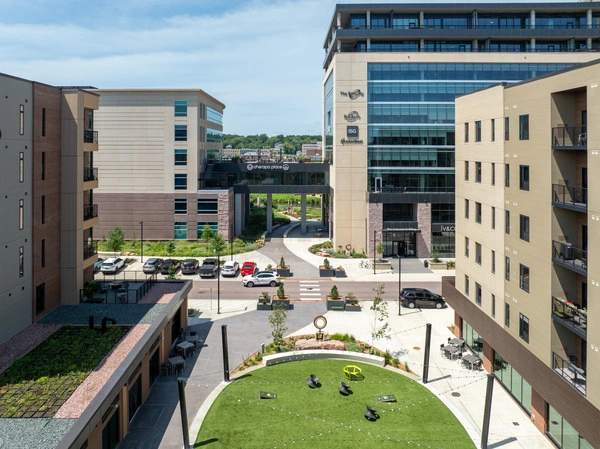Is Mass Timber Right for Your Next Building Project?
Emerging technology and the advancement of forest practices in the 1990s place mass timber in its North American infancy within the building industry timeline. Mass timber construction uses a variety of engineered wood products including columns, beams, floor panels, and wall panels comprised of layers of smaller nominal wood sections.

ISG recently attended the world’s largest gathering of mass timber experts, the International Mass Timber Conference, gaining new insights from experts in forest management, manufacturing, development, and construction. Our experience using the product spans several projects under construction across state lines. To uncover the potential, we’ve pinpointed five factors for evaluating the feasibility of integrating mass timber into your upcoming building project.
Limited utilization
For most across the United States, it’s unlikely you encounter a mass timber building often. Or maybe ever. Research from WoodWorks indicates only 2,115 multi-family, commercial, or institutional mass timber projects are in-progress or built as of March 2024. By using mass timber, you’re creating a different experience for people to enjoy. It’s unique. It’s different. And will continue to create a design impact on the built environment for years to come. Learn more about finished projects in your state on the Woodworks Innovation Network U.S. map of projects.
Scalability
Given the diversity of use and potential impact on our environment, mass timber is utilized across markets. Buildings can have a complete mass timber structural system or partial, where the mass timber components complement a light-frame structure. This versatility means one could consider it in just a small part of a building project like a lobby area. Small area, big impact. Alternatively, for those desiring a bigger effect, timber towers can reach up to 18 stories tall (or more) depending on building use and framing type.

We’ve seen and implemented mass timber into several project types and markets.
- With the evolution of returning to the office, commercial entities use it as a desirable feature to invite employees back into the workspace.
- Multifamily residential, mixed-use buildings are popular, especially with developers who are focused on a distinctive experience to drive a return on investment.
- Retail spaces, restaurants, and hotels tap the material to draw customers into their space.
- The biophilic effect, or the connection with nature, improves end-user wellbeing making it popular for educational facilities and community space including indoor and outdoor venues.
The possibilities are endless.
Sustainability
As our population grows and infrastructure needs expand, the quest for sustainable development is greatly influenced by the potential of mass timber. As a rapidly renewable resource, mass timber has environmental performance benefits due to its life cycle and as an engineered wood material, the resources used to create it vary. Smaller-sized trees, lower-quality lumber, various species, and even waste pieces can be utilized, contributing to more sustainable forestry practices. Substituting wood for other materials in buildings can also greatly decrease the building industry's global carbon emissions. Young trees sequester more carbon dioxide from the atmosphere. Timber construction generates less waste than other building materials.
Building codes
Like any new product or material, the more we know, the easier it is to use. Same with timber. ISG has worked with several Authorities Having Jurisdiction (AHJs)to ensure all parties understand how the system works and can navigate permitting efficiently. We share a common goal with code officials, to ensure superior performance lives in the most minutia of details.
Timber structures aren't as vulnerable to fires as some may think. While unprotected light frame wood construction might pose risks, timber structures outperform unprotected structural steel in fire resistance.
Construction speed
Timber balances function and form. The decision to use it is most advantageous early in the design process. Timber is lighter than concrete or steel and when installing the prefabricated system, it uses less crane picks, increasing construction speed and decreasing equipment rental fees. Not only can the building material be utilized in a load-bearing structural application, but it can distinguish any architectural or interior finish within a space, so there is no need for additional fireproofing, another time and cost savings. All these factors result in faster construction times, saving budget for other needs on a project.
Mass timber inspires ISG’s design approach with a blend of aesthetics and function. With a distinct look, the potential for incredible architecture is immense. Along with its environmental impacts, the makeup of mass timber provides exceptional strength and stability. Connect with ISG designers and engineers to explore the creative forms, connection details and construction methods to determine if mass timber could differentiate your next building project.






-2.webp)
.webp)

-1.webp)


